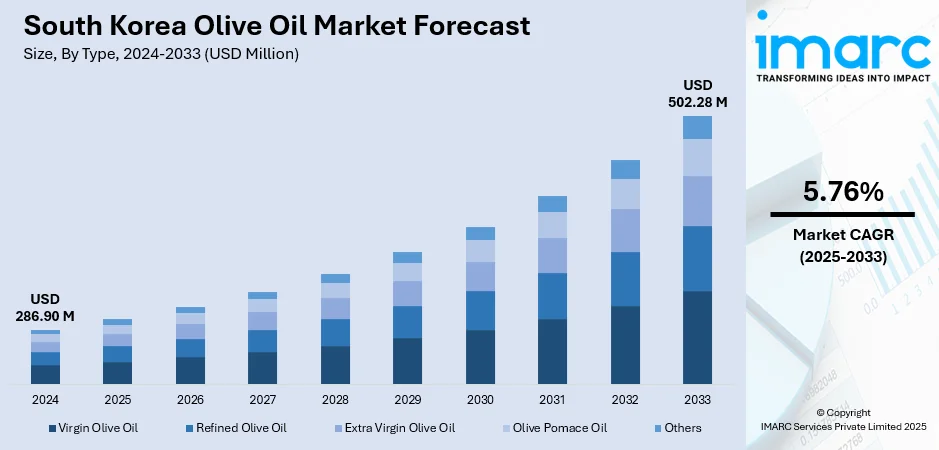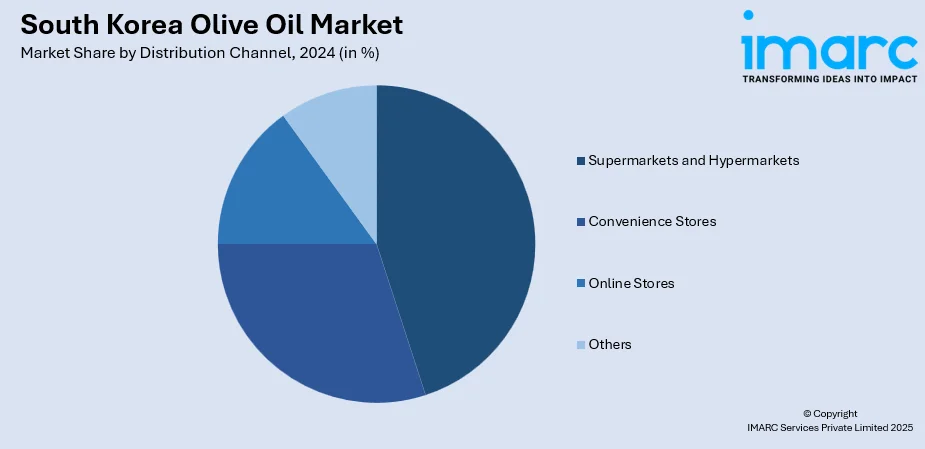
South Korea Olive Oil Market Size, Share, Trends and Forecast by Type, Distribution Channel, Application, and Region, 2025-2033
South Korea Olive Oil Market Overview:
The South Korea olive oil market size reached USD 286.90 Million in 2024. Looking forward, the market is expected to reach USD 502.28 Million by 2033, exhibiting a growth rate (CAGR) of 5.76% during 2025-2033. The market is steadily expanding, driven by growing consumer interest in healthy cooking, international cuisine trends, and lifestyle switching toward premium food products. Supermarkets and online platforms are expanding their olive oil assortments, while local importers collaborate with Mediterranean producers to enhance variety and freshness. As demand for high-quality oils increases, the market continues to mature and diversify, boosting South Korea olive oil market share.
|
Report Attribute
|
Key Statistics
|
|---|---|
|
Base Year
|
2024
|
|
Forecast Years
|
2025-2033
|
|
Historical Years
|
2019-2024
|
| Market Size in 2024 | USD 286.90 Million |
| Market Forecast in 2033 | USD 502.28 Million |
| Market Growth Rate 2025-2033 | 5.76% |
South Korea Olive Oil Market Trends:
Premiumization of Everyday Cooking Oils
In South Korea, olive oil is increasingly seen as a common choice for daily cooking rather than a luxury or niche item. As consumers prioritize health and quality, they are turning to olive oil in place of traditional options like soybean or canola oil. This transformation is fueled by olive oil’s exceptional taste, nutritional benefits, and it’s fit with a premium lifestyle. The trend is notably prominent among younger, urban demographics who are influenced by wellness movements and global culinary trends. Retailers are responding by offering a wider variety of high-quality imported and blended olive oils, thus reshaping consumer tastes and cooking practices, which in turn contributes significantly to South Korea olive oil market growth.

To get more information on this market, Request Sample
Mediterranean and Fusion Cuisine Driving Usage Expansion
The rise of Mediterranean and fusion cuisines in South Korea is having a considerable effect on olive oil use. With more families and restaurants adding international dishes to their offerings, olive oil is increasingly becoming a fundamental cooking ingredient rather than just a salad dressing. This trend is further amplified by cooking shows, food influencers, and chefs who showcase olive oil’s versatility in both Korean and fusion recipes. Consumers in Korea are becoming more adventurous, using olive oil in a wide range of dishes, from pasta and grilled vegetables to Korean-style stir-fries. This blending of cultures is expanding the role of olive oil in various dining occasions, highlighting its significance in the evolving food scene and bolstering the market growth.
Health-focused Purchasing Behavior Reshaping Preferences
The rising health consciousness among South Korean consumers is leading to a notable change in cooking oil choices. Known for its heart-friendly monounsaturated fats and antioxidant properties, olive oil is becoming a favored option for individuals aiming to improve their dietary habits. It is now valued for its taste and its perceived health advantages, such as aiding cholesterol management and lowering inflammation. Consumers actively seek out labels like "extra virgin" and "cold-pressed," which they associate with higher quality and purity. This movement is further supported by increasing awareness initiatives and nutritional information in mainstream media. With health considerations becoming more integral to food purchasing decisions, this shift is crucial in driving growth within the South Korea olive oil market.
South Korea Olive Oil Market Segmentation:
IMARC Group provides an analysis of the key trends in each segment of the market, along with forecasts at the country and regional levels for 2025-2033. Our report has categorized the market based on type, distribution channel, and application.
Type Insights:
- Virgin Olive Oil
- Refined Olive Oil
- Extra Virgin Olive Oil
- Olive Pomace Oil
- Others
The report has provided a detailed breakup and analysis of the market based on the type. This includes virgin olive oil, refined olive oil, extra virgin olive oil, olive pomace oil, and others.
Distribution Channel Insights:

- Supermarkets and Hypermarkets
- Convenience Stores
- Online Stores
- Others
A detailed breakup and analysis of the market based on the distribution channel have also been provided in the report. This includes supermarkets and hypermarkets, convenience stores, online stores, and others.
Application Insights:
- Food and Beverage
- Pharmaceuticals
- Cosmetics
- Others
The report has provided a detailed breakup and analysis of the market based on the application. This includes food and beverage, pharmaceuticals, cosmetics, and others.
Regional Insights:
- Seoul Capital Area
- Yeongnam (Southeastern Region)
- Honam (Southwestern Region)
- Hoseo (Central Region)
- Others
The report has also provided a comprehensive analysis of all the major regional markets, which include Seoul Capital Area, Yeongnam (Southeastern Region), Honam (Southwestern Region), Hoseo (Central Region), and others.
Competitive Landscape:
The market research report has also provided a comprehensive analysis of the competitive landscape. Competitive analysis such as market structure, key player positioning, top winning strategies, competitive dashboard, and company evaluation quadrant has been covered in the report. Also, detailed profiles of all major companies have been provided.
South Korea Olive Oil Market Report Coverage:
| Report Features | Details |
|---|---|
| Base Year of the Analysis | 2024 |
| Historical Period | 2019-2024 |
| Forecast Period | 2025-2033 |
| Units | Million USD |
| Scope of the Report |
Exploration of Historical Trends and Market Outlook, Industry Catalysts and Challenges, Segment-Wise Historical and Future Market Assessment:
|
| Types Covered | Virgin Olive Oil, Refined Olive Oil, Extra Virgin Olive Oil, Olive Pomace Oil, Others |
| Distribution Channels Covered | Supermarkets and Hypermarkets, Convenience Stores, Online Stores, Others |
| Applications Covered | Food and Beverage, Pharmaceuticals, Cosmetics, Others |
| Regions Covered | Seoul Capital Area, Yeongnam (Southeastern Region), Honam (Southwestern Region), Hoseo (Central Region), Others |
| Customization Scope | 10% Free Customization |
| Post-Sale Analyst Support | 10-12 Weeks |
| Delivery Format | PDF and Excel through Email (We can also provide the editable version of the report in PPT/Word format on special request) |
Key Questions Answered in This Report:
- How has the South Korea olive oil market performed so far and how will it perform in the coming years?
- What is the breakup of the South Korea olive oil market on the basis of type?
- What is the breakup of the South Korea olive oil market on the basis of distribution channel?
- What is the breakup of the South Korea olive oil market on the basis of application?
- What is the breakup of the South Korea olive oil market on the basis of region?
- What are the various stages in the value chain of the South Korea olive oil market?
- What are the key driving factors and challenges in the South Korea olive oil market?
- What is the structure of the South Korea olive oil market and who are the key players?
- What is the degree of competition in the South Korea olive oil market?
Key Benefits for Stakeholders:
- IMARC’s industry report offers a comprehensive quantitative analysis of various market segments, historical and current market trends, market forecasts, and dynamics of the South Korea olive oil market from 2019-2033.
- The research report provides the latest information on the market drivers, challenges, and opportunities in the South Korea olive oil market.
- Porter's five forces analysis assist stakeholders in assessing the impact of new entrants, competitive rivalry, supplier power, buyer power, and the threat of substitution. It helps stakeholders to analyze the level of competition within the South Korea olive oil industry and its attractiveness.
- Competitive landscape allows stakeholders to understand their competitive environment and provides an insight into the current positions of key players in the market.
Need more help?
- Speak to our experienced analysts for insights on the current market scenarios.
- Include additional segments and countries to customize the report as per your requirement.
- Gain an unparalleled competitive advantage in your domain by understanding how to utilize the report and positively impacting your operations and revenue.
- For further assistance, please connect with our analysts.
 Request Customization
Request Customization
 Speak to an Analyst
Speak to an Analyst
 Request Brochure
Request Brochure
 Inquire Before Buying
Inquire Before Buying




.webp)




.webp)












